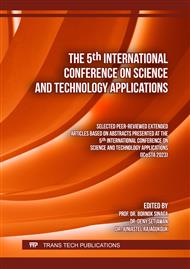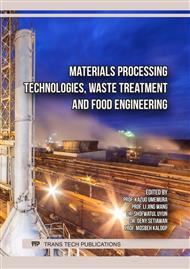[1]
S. Wiriyaumpaiwong and J. Jamradloedluk, "Distillation of Pyrolytic Oil Obtained from Fast Pyrolysis of Plastic Wastes," Energy Procedia, vol. 138, p.111–115, Oct. 2017.
DOI: 10.1016/j.egypro.2017.10.071
Google Scholar
[2]
V. L. Mangesh, S. Padmanabhan, S. Ganesan, D. PrabhudevRahul, and T. D. Kumar Reddy, "Prospects of pyrolysis oil from plastic waste as fuel for diesel engines: A review," IOP Conf Ser Mater Sci Eng, vol. 197, p.012027, May 2017.
DOI: 10.1088/1757-899X/197/1/012027
Google Scholar
[3]
A. Ahamed, A. Veksha, K. Yin, P. Weerachanchai, A. Giannis, and G. Lisak, "Environmental impact assessment of converting flexible packaging plastic waste to pyrolysis oil and multi-walled carbon nanotubes," J Hazard Mater, vol. 390, p.121449, May 2020.
DOI: 10.1016/j.jhazmat.2019.121449
Google Scholar
[4]
D. E. Nikles and M. S. Farahat, "New Motivation for the Depolymerization Products Derived from Poly(Ethylene Terephthalate) (PET) Waste: a Review," Macromol Mater Eng, vol. 290, no. 1, p.13–30, Jan. 2005.
DOI: 10.1002/mame.200400186
Google Scholar
[5]
J. P. Simanjuntak, S. Anis, M. Syamsiro, Baharuddin, E. Daryanto, and B. H. Tambunan, "Thermal Energy Storage System from Household Wastes Combustion: System Design and Parameter Study," Journal of Advanced Research in Fluid Mechanics and Thermal Sciences, vol. 80, no. 2, p.115–126, Mar. 2021.
DOI: 10.37934/arfmts.80.2.115126
Google Scholar
[6]
Q. Gan, J. Cui, and B. Jin, "Environmental microplastics: Classification, sources, fates, and effects on plants," Chemosphere, vol. 313, p.137559, Feb. 2023.
DOI: 10.1016/j.chemosphere.2022.137559
Google Scholar
[7]
S. D. A. Sharuddin, F. Abnisa, W. M. A. W. Daud, and M. K. Aroua, "Pyrolysis of plastic waste for liquid fuel production as prospective energy resource," IOP Conf Ser Mater Sci Eng, vol. 334, p.012001, Mar. 2018.
DOI: 10.1088/1757-899X/334/1/012001
Google Scholar
[8]
Janter Pangaduan Simanjuntak, Bisrul Hapis Tambunan, and Junifa Layla Sihombing, "Potential of Pyrolytic Oil from Plastic Waste as an Alternative Fuel Through Thermal Cracking in Indonesia: A Mini Review to Fill the Gap of the Future Research," Journal of Advanced Research in Fluid Mechanics and Thermal Sciences, vol. 102, no. 2, p.196–207, Feb. 2023.
DOI: 10.37934/arfmts.102.2.196207
Google Scholar
[9]
M. S. Qureshi et al., "Pyrolysis of plastic waste: Opportunities and challenges," J Anal Appl Pyrolysis, vol. 152, p.104804, Nov. 2020.
DOI: 10.1016/j.jaap.2020.104804
Google Scholar
[10]
M. Z. H. Khan, M. Sultana, M. R. Al-Mamun, and M. R. Hasan, "Pyrolytic Waste Plastic Oil and Its Diesel Blend: Fuel Characterization," J Environ Public Health, vol. 2016, p.1–6, 2016.
DOI: 10.1155/2016/7869080
Google Scholar
[11]
A. G. M. B. Mustayen, M. G. Rasul, X. Wang, M. A. Hazrat, M. I. Jahirul, and M. Negnevitsky, "Plastic-made diesel (PMD) from pyrolysis via vacuum distillation process- A waste recycling fuel to diesel engine performance and emissions improvement," Journal of the Energy Institute, vol. 107, p.101198, Apr. 2023.
DOI: 10.1016/j.joei.2023.101198
Google Scholar
[12]
R. Miandad, M. A. Barakat, A. S. Aburiazaiza, M. Rehan, I. M. I. Ismail, and A. S. Nizami, "Effect of plastic waste types on pyrolysis liquid oil," Int Biodeterior Biodegradation, vol. 119, p.239–252, Apr. 2017.
DOI: 10.1016/j.ibiod.2016.09.017
Google Scholar
[13]
M. Mani, C. Subash, and G. Nagarajan, "Performance, emission and combustion characteristics of a DI diesel engine using waste plastic oil," Appl Therm Eng, vol. 29, no. 13, p.2738–2744, Sep. 2009.
DOI: 10.1016/j.applthermaleng.2009.01.007
Google Scholar
[14]
B. H. Tambunan, S. Siman, and J. P. Simanjuntak, "Pyrolysis of Plastic Waste into The Fuel Oil," in Proceedings of the Proceedings of the 2nd Annual Conference of Engineering and Implementation on Vocational Education (ACEIVE 2018), 3rd November 2018, North Sumatra, Indonesia, EAI, 2019.
DOI: 10.4108/eai.3-11-2018.2285610
Google Scholar
[15]
T. Maqsood, J. Dai, Y. Zhang, M. Guang, and B. Li, "Pyrolysis of plastic species: A review of resources and products," J Anal Appl Pyrolysis, vol. 159, p.105295, Oct. 2021.
DOI: 10.1016/j.jaap.2021.105295
Google Scholar
[16]
M. Nahid, S. S. H. H. Redhwi, and M. F. Ali, "Study on the conversion of waste plastics/petroleum resid mixtures to transportation fuels," J Mater Cycles Waste Manag, vol. 6, no. 1, p.27–34, Mar. 2004.
DOI: 10.1007/s10163-003-0102-x
Google Scholar
[17]
W. Arjharn, P. Liplap, S. Maithomklang, K. Thammakul, S. Chuepeng, and E. Sukjit, "Distilled Waste Plastic Oil as Fuel for a Diesel Engine: Fuel Production, Combustion Characteristics, and Exhaust Gas Emissions," ACS Omega, vol. 7, no. 11, p.9720–9729, Mar. 2022.
DOI: 10.1021/acsomega.1c07257
Google Scholar
[18]
B. K. Sharma, B. R. Moser, K. E. Vermillion, K. M. Doll, and N. Rajagopalan, "Production, characterization and fuel properties of alternative diesel fuel from pyrolysis of waste plastic grocery bags," Fuel Processing Technology, vol. 122, p.79–90, Jun. 2014.
DOI: 10.1016/j.fuproc.2014.01.019
Google Scholar
[19]
M. Chandran, S. Tamilkolundu, and C. Murugesan, "Investigation of the performance, combustion parameters and emissions analysis on DI engine using two staged distilled waste plastic oil-diesel blends," Thermal Science, vol. 22, no. 3, p.1469–1480, 2018.
DOI: 10.2298/TSCI170501067C
Google Scholar



